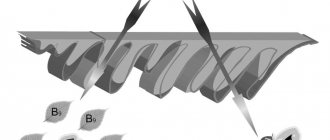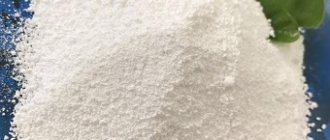It is used in the production of viscose, mineral paints, glazes, in metallurgy (flotation agent), in medicine and agriculture, as well as in batteries and chemical energy sources. It can be used as a raw material for the chemical industry, and zinc sulfate is also in demand in pharmaceutical production, where it is used to prepare various medicines.
Pharmacological properties
Zinc sulfate is an antiseptic that is obtained by evaporating zinc and sulfuric acid. To obtain the required concentration, a hydrolysis reaction is used.
Zinc sulfate ions have the ability to coagulate protein compounds, resulting in the formation of complexes (albuminates). This is due to the antiseptic, drying and astringent effect of this medicine. Due to coagulation, zinc sulfate leads to the death of microorganisms. When used topically in ophthalmology, systemic effects are minimal.
Precautionary measures
Zinc sulfate belongs to the 2nd class of danger to humans. Its crystalline hydrates are also toxic. Dust and aerosols have an irritating effect on the skin (up to the formation of ulcers), mucous membranes of the eyes and respiratory organs. Harmful if swallowed and may cause diarrhea and vomiting. Can accumulate in the body. Very dangerous for the environment and especially for aquatic organisms. Therefore, the disposal of waste and used containers should be entrusted to companies specializing in the processing (destruction) of hazardous waste.
In production, workers must use respirators, safety glasses and rubber gloves. The workroom must be equipped with forced ventilation.
If dust gets into your eyes, rinse them thoroughly and consult a doctor.
Zinc sulfate is stored in an airtight container that protects the substance from air and moisture; in warehouses with built-in ventilation, with temperature control: storage t should be at least +2 °C and no more than +40 °C.
Application of zinc sulfate and its crystalline hydrates
• For the production of viscose fibers and fabrics; mineral dyes, enamels, glazes; as a raw material in the chemical industry. • In the mining industry - as a flotation reagent in metal mining. • In medicine and pharmacology - for the production of antiparasitic, antiseptic, bactericidal drugs; astringents, drying agents; immune stimulants; eye drops; dental products. Medicines are used to treat conjunctivitis and other inflammatory eye diseases, laryngitis, urethritis, etc. and also to replenish zinc deficiency in the body; in the treatment of diabetes mellitus; kidney and liver diseases; cerebral palsy; baldness, etc. • Easily soluble zinc- and sulfur-containing microfertilizer, which increases crop yields, the speed of fruit ripening and their nutritional value, plant resistance to diseases and bad weather (cold, heat, drought). Suitable for any type of soil. It is used to treat seeds and protect them from mold and other diseases. • A food additive in animal and bird feed that stimulates appetite and improves immunity. • In the textile industry - mordant before dyeing fabrics. • For the manufacture of chemical current sources. • In demand in electroplating, the pulp and paper industry (for bleaching paper pulp), and in laboratory practice; to protect wood from rotting.
Physical properties:
| 200 | Physical properties |
| 201 | Density |
| 202 | Melting temperature |
| 203 | Boiling temperature |
| 204 | Sublimation temperature |
| 205 | Decomposition temperature* |
| 206 | Self-ignition temperature of a gas-air mixture |
| 207 | Specific heat of fusion (enthalpy of fusion ΔHpl) |
| 208 | Specific heat of evaporation (enthalpy of boiling ΔHboiling) |
| 209 | Specific heat capacity at constant pressure |
| 210 | Molar heat capacity |
| 211 | Molar volume |
| 212 | Thermal conductivity |
| 213 | Thermal expansion coefficient |
| 214 | Thermal diffusivity coefficient |
| 215 | Critical temperature |
| 216 | Critical pressure |
| 217 | Critical Density |
| 218 | Triple point |
| 219 | Solubility in water and other liquids |
| 220 | Vapor pressure (mmHg) |
| 221 | Vapor pressure (Pa) |
| 222 | Standard enthalpy of formation ΔH |
| 223 | Standard Gibbs energy of formation ΔG |
| 224 | Standard entropy of matter S |
| 225 | Standard molar heat capacity Cp |
| 226 | Enthalpy of dissociation ΔHdiss |
| 227 | The dielectric constant |
| 228 | Magnetic type |
| 229 | Curie point |
| 230 | Neel temperature |
| 231 | Volume magnetic susceptibility |
| 232 | Specific magnetic susceptibility |
| 233 | Molar magnetic susceptibility |
| 234 | Electric type |
| 235 | Electrical conductivity in the solid phase |
| 236 | Electrical resistivity |
| 237 | Superconductivity at temperature |
| 238 | Critical magnetic field of superconductivity destruction |
| 239 | Prohibited area |
| 240 | Charge carrier concentration |
| 241 | Mohs hardness |
| 242 | Brinell hardness |
| 243 | Vickers hardness |
| 244 | Sound speed |
| 245 | Surface tension |
| 246 | Dynamic viscosity of gases and liquids |
| 246 | Explosive concentrations of gas-air mixture, % volume |
| 247 | Explosive concentrations of a mixture of gas and oxygen, % volume |
| 248 | Ultimate tensile strength |
| 249 | Yield strength |
| 250 | Elongation limit |
| 251 | Young's modulus |
| 252 | Shear modulus |
| 253 | Bulk modulus of elasticity |
| 254 | Poisson's ratio |
| 255 | Refractive index |
How to store, safety precautions
Reference . According to the Classification of Harmful Substances and General Safety Requirements, the drug is classified as hazard class 2 (GOST 8723-82 Zinc sulfate).
Personal protective measures:
- Zinc sulfate heptahydrate is a highly dangerous substance ;
- microparticles can enter the body through the respiratory and digestive systems, through the skin (even intact);
- the drug is poisonous and toxic;
- if the rules and regulations for storage and use are violated, it causes a burn to the oral mucosa and damage (ulcers, atrophy, erosion) to the back of the hand, skin surfaces, and upper respiratory tract;
- the drug is stored in packaging from the manufacturer, in a special room with good ventilation;
- when contacting zinc sulfate (preparation of solutions, processing), use safety glasses, a respirator or gauze mask, special work clothes and technical utensils;
- after working with the drug, take a shower, wash your hands and face thoroughly, a change of clothes and underwear is required;
- It is strictly forbidden for children and women to work with the substance during pregnancy and lactation.
Attention! In case of accidental ingestion of particles or fertilizer solution, signs of poisoning, or an allergic reaction, immediately seek medical help .
ZnSO4 • 7H2O M.m. 287.56g/mol
White vitriol.
Zinc sulfate Zinci sulfas.
In nature, zinc occurs in the form of gallium minerals ZnCO3 and zinc blende ZnS. Zinc is found in muscle and dental nervous tissue of the human body. The use of zinc compounds in medicine is based on the fact that zinc, like some other heavy metals, produces compounds with proteins - albuminates; soluble albuminates have an effect ranging from weakly astringent to sharply cauterizing. Insoluble albuminates usually form a film on the tissue surface and thus promote tissue healing (drying effect).
Zinc compounds are toxic in large doses; when applied topically, they can be used as astringents and cauterizing agents; when administered orally, zinc compounds cause vomiting.
Receipt
Zinc sulfate is obtained by dissolving metallic zinc purified from impurities and diluted sulfuric acid:
Zn + H2SO4 → ZnSO4 + H2↑
Zinc sulfate heptahydrate (ZnSO4 •7H2O) is crystallized from the solution at a temperature of 39-41 °C.
Properties
Colorless transparent crystals or odorless fine crystalline powder with an astringent metallic taste. It erodes in air, and at 280°C it completely loses its water of crystallization. Very easily soluble in water, slowly in glycerin. Its aqueous solutions are acidic and practically insoluble in ethanol.
Chemical properties
Zinc compounds exhibit amphoteric properties. When zinc oxide is dissolved in mineral acids, it forms salts: sulfates in sulfuric acid, chlorides in hydrochloric acid, nitrates in nitric acid:
ZnO + H2SO4 → ZnSO4 + H2O
ZnO + 2HCl →ZnCl2 + H2O
ZnO + 2HNO3 → Zn(NO3)2 + H2O
When zinc oxide is dissolved in excess solutions of alkali metal hydroxides, water-soluble hydroxo complexes are formed:
ZnO + 2NaOH +H2O → Na2[Zn(OH)4]
When dissolved in excess ammonia, a soluble complex salt is formed:
ZnO + 4NH4ONH → [Zn(NH4)4](OH)2 + 3H2O
Authenticity.
Zinc cation is proven by official reactions:
1. With sodium sulfide to form a white precipitate of zinc sulfide, insoluble in acetic acid, soluble in mineral acids:
ZnSO4 + Na2S → ZnS↓+Na2SO4
ZnS+HCl →ZnCl2+H2S↑
2. With potassium hexacyanoferrate (II) to form a white gel-like precipitate of a complex salt, insoluble in acids, soluble in alkali solutions:
ZnSO4 + K4[Fe(CN)6] → K2Zn[Fe(CN)6]↓ + K2SO4
K2Zn[Fe(CN)6] + 4NaOH → Na2[Zn(OH)4] + K2Na2[Fe(CN)6]
3. A specific (not official) reaction to zinc in all its compounds is the formation of Rinman green. Zinc oxide is calcined with cobalt nitrate, resulting in a characteristic green color - Rinman green
4. The sulfate ion in zinc sulfate is confirmed with barium chloride by the formation of a white precipitate of barium sulfate, insoluble in acids and alkali solutions:
ZnSO4 + BaCl2 → BaSO4↓+ ZnCl2
Purity test.
1. Establish acceptable general impurities : chlorides, arsenic (using standard solutions)
2. Unacceptable general impurities
Ø iron, copper and aluminum are detected by reaction with an ammonia solution (the test solution must be transparent and colorless);
Ø magnesium and calcium - by reaction with sodium hydrogen phosphate (the solution should remain unchanged);
Ø nitrites - by reaction with diphenylamine (blue coloring should not appear at the boundary of the layers);
Ø carbonates - by reaction with dilute hydrochloric acid (no release of gas bubbles should be observed; the solution should be colorless and transparent).
3. Control acidity visually using pH indicators (methyl orange or phenolphthalein).
Quantification
Trilonometric method (by zinc ion), which is based on the formation of strong, colorless, highly soluble metal complexes with trilon B, similar to the determination of magnesium and calcium compounds), f = 1.
Storage.
Zinc preparations are stored in well-closed containers; zinc sulfate loses its water of crystallization in air. According to list B.
Application.
Zinc sulfate is used in ophthalmic practice for conjunctivitis (0.1-0.5% solutions), for laryngitis (0.25-0.5% solutions for lubrication or spraying), orally for the prevention of hypozincemia and an emetic.
Release form:
Substance, eye drops in glass bottles and plastic dropper tubes, ointments, pastes, liniments.
Zinc sulfate - additive to animal feed
This chemical can also serve as a source of zinc for the livestock industry, used as a dietary supplement for farm animals. Zinc in the diet of livestock is necessary to normalize all metabolic phenomena occurring in their bodies, to stimulate appetite, and normalize the immune system.
A deficiency of this chemical element in an animal’s body can lead to diseases such as parakeratosis, hypogonadism, nosebleeds and other negative phenomena, such as deterioration of fur and a decrease in overall productivity in individuals.
The use of zinc sulfate allows you to avoid all of these negative phenomena. A significant improvement is observed within 24 hours after the animals start eating food with this supplement. The additive is used when raising cattle, horses, pigs, poultry and other breeds.
Advantages and disadvantages
Advantages of zinc sulfate fertilizer:
- catalyst for enzyme systems, ensures complete respiration of plants;
- utilizes inorganic phosphorus in the soil;
- participates in the formation of auxins (natural growth hormones);
- provides protection for fruit, berry, and vegetable crops from temperature stress (heat, desiccation, sharp daily fluctuations, seasonal cold snaps);
- eliminates zinc starvation on carbonate soils, prevents dry tops of fruit trees;
- applicable for all vegetable, fruit, ornamental and meadow (forage grasses, green manure) plants;
- unlike zinc chelate, the concentration of active substances of zinc sulfate is 2 times higher;
- the drug is inexpensive, the price is an order of magnitude lower than, for example, manganese sulfate, zinc chelate and other multicomponent mineral complexes.
Attention! Science has proven that 95% of all plants need an accessible form of zinc and up to 98-100% of all soils need zinc.
Flaws:
- ineffective on acidified soils; due to the competition of other ions, the beneficial microelement is gradually leached;
- saturation of the soil with organic matter promotes the binding of zinc into stable forms; zinc accumulates in peat and organic soil horizons;
- the effectiveness of the fertilizer, its complete assimilation by plants is directly related to the full saturation of other vital minerals (selenium, cobalt, iron, manganese, boron, etc.);
- an increase in the concentration of nitrogen and phosphorus increases the risk of zinc starvation in garden crops;
- sulfur as a component of fertilizing is easily absorbed by the root system, but under the influence of spring waters and seasonal precipitation it is quickly washed out (migrates into infertile layers), especially from light soils.
Effect on plants and soil
Benefits of zinc sulfate for soil:
- the lack of zinc is especially evident in neutral, humus soils with a high concentration of phosphorus;
- zinc fertilizers are necessary to stabilize structural soil processes on turf, brown, humus-carbonate, chestnut soils, as well as on light sandstones, gray soils and chernozems:
- acidic, carbonate, calcareous soil types are characterized by a high concentration of clay minerals, calcium carbonate, are susceptible to weathering, plants may lack zinc in an accessible form;
- timely application to the soil optimizes the microbiological activity of macro- and microelements.
Important! In soil, zinc sulfate is quite stable and practically does not differ from the action of chelate forms.
Benefits of zinc sulfate for plants:
- zinc is part of more than 40 organic enzymes and enzymes as an integral component (photosynthesis and respiration);
- Plant experts say that sulfur is the 4th most important nutrient after nitrogen, phosphorus and potassium; onions, garlic and cabbage consume 2-3 times more sulfur than other vegetables;
- affects the permeability of cell membranes, stabilizes the components of the plant cell and the entire system of microorganisms;
- in drought conditions, zinc, like selenium, provides plants with protection and increases resistance to fungal and viral diseases;
- in cold regions and zones with a temperate climate ensures 100% ripening of berries and fruits by accelerating the ripening period;
- stimulates energy exchange and plant metabolism, directly participates in the exchange of phosphates, proteins, carbohydrates, starch;
- participates in the formation of ribosomes, DNA, phytohormones;
- optimizes growth processes (formation and development of internodes, leaves, stems, rosettes).
Instructions for using fertilizer
Technical zinc sulfate heptahydrate (zinc sulfate, heptahydrate) for basic application over large areas is produced in 25 kg bags.
For small summer cottages, the drug is produced in granular form or in the form of crystalline powder, in convenient protected packaging of 20 g, 0.12 kg, 1 kg.
Before use, it is important to carefully read the attached instructions, review the release date and expiration dates of the product, study the composition and methods of use.
When preparing solutions, you must strictly adhere to the recommended dosages, regimen and consumption rates.
Causes of zinc deficiency in plants
Throughout the entire summer season, and especially at the beginning, plants need adequate nutrition. Along with the basic NPK complex (nitrogen-phosphorus-potassium), rare earth microelements (rare earth metals) are needed.
The main reason for the lack of zinc in the soil is an increase in the concentration of nitrogen and phosphorus components in the structural components of the soil.
When phosphorus fertilizers are added to the soil, antagonism occurs between phosphorus and zinc (zinc becomes unavailable to plants). Zinc deficiency is also caused by carbonate content and increased soil acidity (pH level above 7-8 units).






